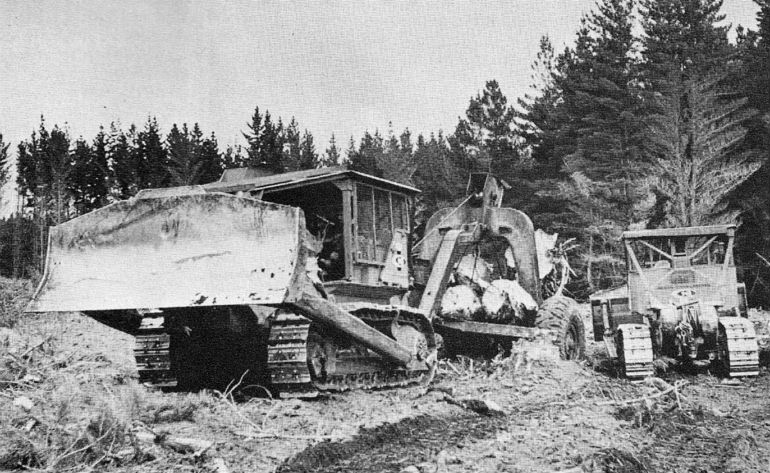Replacing the previous model HD-15 in the Allis-Chalmers line of track type tractors the HD-16 was introduced with much fanfare in 1955. By Richard Campbell
Physically, the Allis-Chalmers HD-16 was a little larger than its predecessor and featured one of the newly acquired Buda diesels. Up until 1955 Allis-Chalmers tractors had been fitted with General Motors’ diesels but, with the buyout of Buda in 1953, Allis-Chalmers now had its own range of diesel engines.
Allis-Chalmers wasted no time in developing the Buda range, re-badging as it went.
The initial model of the HD-16 was powered with a model HD-844 six-cylinder, naturally aspirated, inline diesel, rated at 148 horsepower. A nice feature of the HD-844 engine was direct electric starting. At the time, both of Allis-Chalmers’ major competitors still relied on alternative methods to start their diesel engines or offered direct starting as an option at considerably increased cost.
A choice of two transmission types were offered: a six-speed direct drive and a three-speed torque converter drive. It is worthy to note at this point that Allis-Chalmers was a pioneer in the use of torque converters, its first tractor featuring this device (the model HD-19) appearing in 1947 several years before any other tractor manufacturer.
With standard transmission the HD-16 was capable of 5.8mph and with the torque converter transmission a slightly faster 7.2mph.
At the drawbar, in low gear an HD-16 could pull 16,300kg with the direct drive transmission and 27,200 kg with the torque converter transmission.
Like most track type tractors of its era, steering was accomplished by hydraulically controlled clutches and contracting band brakes. The brakes could be adjusted externally without having to get into the main case, quite a labour saving feature and common to Allis-Chalmers track tractors.
The HD-16 was supplied with a 74 inch gauge, six-roller track frame, with two carrier rollers.
Standard track was 38-section with a 20 inch track shoe, although optional size shoes could be fitted.
Concerning the undercarriage, it is also worthy to note here that Allis-Chalmers was the first track type tractor manufacturer to offer extended life rollers and idlers at a time when most machines had to have their rollers and idlers lubricated on a daily basis.
From the seat the operator had a good view to both sides of the machine and, due to the narrow width of the fuel tank, an excellent view to the rear as well for monitoring towed equipment.
The bonnet was tapered from the rear and apart from the obligatory air cleaner, allowed a very good view forward for dozing operations.
An adjustable well padded seat was supplied as standard equipment and full instrumentation was provided for the operator to monitor critical machine functions. A fully enclosed cab with heater was optional for winter operations.
Equipment
By the time the HD-16 was introduced, Allis-Chalmers had absorbed Baker, its chief supplier and manufacturer of bulldozer blades, PCUs, rippers and towed scrapers and was marketing them under the Allis-Chalmers trademark. Another supplier, Garwood, had also been acquired.
GarWood manufactured good quality winches and was a respected name in hydraulics at the time.
With both these manufacturers now part of the Allis-Chalmers family, the range of attachments that could be fitted to the HD-16 was extensive, and a machine ordered from the factory could be built to the customer’s specifications, including unusual attachments, in house.
Both direct drive and torque converter drive machines were built and improved upon up until the late 1960s, when a powershift model was introduced to supplement the range and substantial other changes were made to the machine. The powershift machine (which also had a different engine) is beyond the scope of this article and will be covered in part two of the HD-16 story, to be published at a later date.
The New Zealand Connection
The HD-16 was a popular tractor, especially in the forest, and Allis-Chalmers franchise holder CablePrice imported over 200 during the years the machine was in production.
Both NZ Forest Products and the Kaingaroa Logging Co had large fleets of these machines, as did many general earthmoving contractors, and the type could be found throughout New Zealand in quarries, cutting tracks, stockpiling, pulling scrapers, ripping and generally getting into mischief.
While most have now gone to scrap, there are some examples to be found (unfortunately not all operational).
Many of the later model HD-16s and 16Bs can still be found putting in an honest day’s work.
Brief Specifications – Allis-Chalmers HD-16A
(These specifications are for a late 50s direct drive machine)
Engine: Allis-Chalmers HD-844, six-cylinder, inline, naturally aspirated
Horsepower: 148 at 1600rpm
Transmission: Allis-Chalmers six-speed, constant mesh, six speeds forward and
three reverse.
Speeds: 1st: 1.4mph, 2nd: 2.1mph, 3rd: 3mph, 4th: 3.8mph, 5th: 4.5mph, 6th: 5.8mph
Clutch: Single plate over centre type with cerametallic lining
Steering: Hydraulically actuated multiple disc clutches
Brakes: Contracting band
Max.drawbar pull: 16,300kg
Gauge: 74 inch
Std.Track Shoe: 20 inch
No. Rollers six per side with two carrier rollers per side
Operating Weight: 14 tons (bare)

